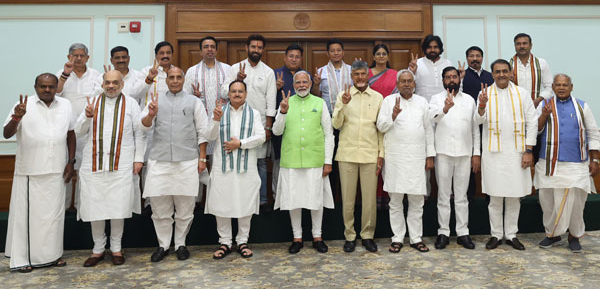Structure of Modi 3.0: After the Lok Sabha election results, 3 things are being discussed the most. 1. Who will form the government? 2. What will be the structure of the cabinet and 3. What will be the role of Nitish Kumar and Chandrababu Naidu in the new government?
By attending the meeting of the National Democratic Alliance, Chandrababu Naidu and Nitish Kumar have almost cleared the picture of government formation. This NDA meeting was held at Narendra Modi ‘s official residence.
Table of Contents
However, the picture regarding government formation is still complicated. In this special story, we will understand these complicated issues in detail through 6 questions and their answers.
1. What could be the cabinet formula?
In 2014 and 2019, BJP came to power on its own strength. The party had then decided to give a symbolic share to its allies. At that time, JDU had openly opposed it and demanded a share according to the numbers. However, BJP refused to give a share based on numbers.
This time the scenario has completely changed. BJP is 33 steps away from the majority and is dependent on NDA allies to form the government. In such a situation, a new formula for cabinet formation can be made this time.
According to JDU sources, the party will try to implement this formula in the cabinet expansion this time. If the formula is decided on the basis of numbers, then one minister can be made for every 3.6 MPs in the cabinet.
This formula is as follows- X/M= picture of the Council of Ministers
Here X means total MPs of NDA
M means total posts in the cabinet.
Total NDA MPs/total cabinet positions (NDA has 296 MPs and 81 cabinet positions)
A JDU MP, on the condition of anonymity, says- When Atal Bihari Vajpayee’s government was formed in 1999, even then NDA had got only 296 seats. This time too the figure is around the same.
A total of 72 ministers were appointed in Atal Bihari’s government, out of which 17 ministers were from the alliance parties. 55 ministers were appointed from BJP quota in Atal government. However, at that time BJP had won only 182 seats.
2. What will be the role of JDU and TDP?
TDP is the second largest party in NDA while JDU is the third largest party. The foundation of the government rests on the numbers of both the parties. There are many discussions about both the parties, but at present both are with NDA.
If both remain together till the formation of the government, then JDU-TDP may dominate the cabinet.
JDU can get 3-4 ministerial posts, while TDP can also get 5-6 ministerial posts based on the numbers. Both the parties can also be given big departments. In Atal Bihari’s government, George Fernandes was given important departments like defense.
Nitish Kumar was given the responsibility of the Railway Ministry in that government. Similarly, TDP can also be given one of the top-5 departments.
Apart from this, 7 MPs of Shiv Sena (Shinde) have been elected to the Lok Sabha. Shiv Sena can also get 2 ministerial posts. Shiv Sena (United) got one ministerial post in 2014 and 2019. The party was given the department of Heavy Industries Ministry in the government.
3. Will there be adjustment of smaller parties in the government?
LJP (R), which is a part of NDA, has got 5 seats while RLD, JDS and Jansena Party have got 2 seats each. These parties may also get priority in the cabinet.
Apart from this, NCP, Apna Dal, HAM (S), AJSU, UPPL and AGP have got 1 seat each. The parties that won 1 seat each in 2014 and 2019 were not included in the government.
However, this time the picture is completely different. In such a situation, it is possible that these parties may be included in the government.
4. How many ministers will be made from BJP quota in the government?
No official formula has been revealed yet regarding the formation of the government, but the formula that is coming out regarding the cabinet. If it is implemented, then 60-65 ministers from BJP can be made in the government.
However, it all depends on the strength of the cabinet. In 2014, Modi took oath with 45 ministers and in 2019 with 54 ministers. There can be 81 ministers in the Union Cabinet including the Prime Minister.
5. What will happen to the post of Speaker and Deputy Speaker?
In 2014 and 2019, BJP was in power with full majority. Both times the party got the Speaker appointed from its own quota. However, this time it is in a coalition government.
During Atal Bihari’s time, the post of Speaker was given to TDP and Shiv Sena. GMili Balayogi from TDP and Manohar Joshi from Shiv Sena became Speaker.
English newspaper Indian Express has published a report quoting high sources of TDP. According to this, like last time, TDP has demanded the Speaker’s chair this time too.
However, till now neither BJP nor TDP has given any statement regarding this.
6. Will anything change within the BJP in the government?
If the BJP has to give big departments to its allies, it can have an impact at the top level. Apart from the Prime Minister’s Office, Finance, Foreign Affairs, Home Affairs, Defence and Transport are considered big departments at the central level.
Apart from this, 19 BJP ministers have lost the elections this time. These include big names like Smriti Irani, Arjun Munda, Mahendra Nath Pandey. In such a situation, new faces may be given preference in their place.

